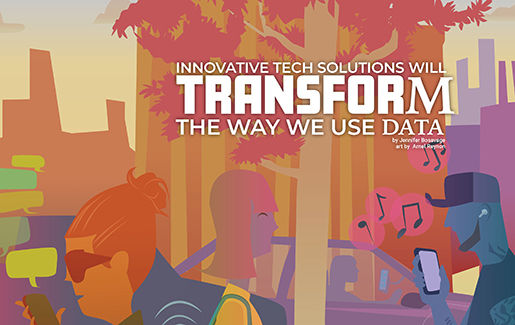
Tech businesses have spent the last generation ensuring that customers have real-time, secure access to their information anytime, anywhere. But soon—or even now in some cases—it won’t be enough. Increasingly, customers expect their IT providers to help them analyze the data, gleaning new insights that can help them make better, more informed business decisions. It’s a big opportunity for MSPs and their brethren, especially for those acting quickly, to meet these new demands.
Customer demand for data-driven solutions has been fueled by a larger trend in the market—one where the end user yields more influence in what they buy and how they buy and consume IT, according to Heather Harlos, head of MSP marketing at JumpCloud. “If you look at the history and evolution of the channel, you will see a significant shift,” she said. “Fifteen years ago, it was the vendor to distributor to reseller to end user, with the vendor determining what the next need would be regarding product development. Now the customer is deciding that.”
As end users influence the development of products, services and delivery models, MSPs serve as conduits to ensure that the wants of both end users and vendors are aligned. Gone are the days of vendors handing down a one-size-fits-all approach to their partners and end users. As a result, solution providers are busy differentiating themselves from their competitors by adding business value—increasingly by offering advanced data analysis solutions to do so. “MSPs are the chefs in the channel creating unique meals for their customers to consume,” Harlos said. “They’re starting to distinguish themselves by the partnerships they build and the true value they add to their customer base. They need to be integral partners of the business and not seen as purely providing a product or service that can easily be sourced by any other MSP in the market. MSPs need to understand the technology and also understand the business, its pain points, and how they can create efficiencies and increase overall profitability for the customers they serve.”
Identifying Data Opportunities for Growth
To accomplish all this, MSPs must possess the ability to analyze customers’ data to best determine needs and strategies to solve business problems. “MSPs need to be able to identify surface gaps and best practices, and leverage all of that to make sound business-driven recommendations at the highest levels,” Harlos said. “Customers are more technical than they were years ago and through technology advancements, they can troubleshoot on their own without a third party. This means that an MSP’s value is now through the partnership they build and their ability to do more than IT support.”
But if MSPs themselves can't―or aren't willing to―dig deep to assist their customers with expansion efforts, they likely will be challenged to grow and scale themselves. Differentiating in a crowded market is key for many MSPs, especially if they're looking to not only survive but also thrive.
“There's only so much scale you can achieve by offering commoditized infrastructure monitoring and management,” said Kris Blackmon, chief channel officer at JS Group and member of CompTIA's Channel Development Advisory Council. “The margin opportunity from traditional managed services continues to decline. Partners have to start selling additional value that combines modern technology and their own expertise. Your customers have to go somewhere for more advanced solutions that support their business mandates; most of them have neither the time nor the skillset to tackle digital transformation initiatives. It's an easier upsell with much greater margin opportunity.”
Unlocking New, Maybe Limitless, Possibilities
While many businesses today are analyzing the data they’re generating to some extent, most aren’t fully aware of what's possible, because they haven’t researched based on it, or no one has explained it to them. There’s a lot more they could be doing—and there lies the opportunity.
“MSPs can help their clients make use of the new data sources available to them,” said Jacqui Murphy, senior corporate communications manager at Auvik Networks, and a member of CompTIA's Business Applications Advisory Council.
“This data comes from assets they've invested in to help run their businesses. There's a reason they've made these investments, and almost every piece of hardware and every software platform offers goldmines of useful data.”
For example, marketing automation systems provide data associated with the delivery and engagement of marketing programs. Recruiting software offers data associated with volume, quality and engagement of potential employees, she added.
“And when data from different sources is combined into one centralized data repository, real magic and business insights can be uncovered (e.g., an increase in marketing spend this week resulted in 50 new qualified sales leads).”
The amount of data created every year continues to spiral upward, reaching 181 zettabytes (ZBs) by 2025, up from 79 ZBs in 2021 and 64 ZBs in 2020, according to Statista. But most of it is unused or little value is extracted from it, according to Blackmon.
“We've collected so much data over the last decade that businesses struggle to know what's valuable and what's just noise,” Blackmon said.
True data analysis also requires systems, processes and expertise that are beyond the reach of many organizations, she added.
“The result is that they're sitting on truckloads of valuable metrics, but they have no idea how to leverage it. Much of this data surrounds the evolving buyer's journey. While customers may know the basics of moving leads through the pipeline, they can't tie it together in one comprehensive view of true end-to-end customer experience.”
Avoiding ‘Data Rich, Insight Poor’ Pitfalls
So how can MSPs better help customers get more from their data? A great place to start is focusing on extracting value from data that will directly grow the business, according to Wendi O’Neill, director of data solutions at Sirius
Computer Solutions, a San Antonio-based solution provider. “We are becoming data rich but insight poor. I think it’s a big challenge for businesses to get the most value from their data today for two main reasons,”
O’Neill said. “First is the lack of a true data governance program. And I want to emphasize that I said a program, not a project. Data governance programs bring better data integrity, quality, trust and security. It sets data users up for better data literacy and understanding of their data and where it is coming from.”
"The second area is the need to modernize data management systems. You can get to advanced analytics and truly leverage AI and ML with many traditional systems that are overly costly, complex and constrained.”
Businesses need to evolve to modernize their data management solutions and operations to bring in automation and agility to gain the maximum value from their data, O'Neill added.
Helping customers get more from their data is one of the biggest opportunities for the channel over the next 5+ years, said O’Neill. Her company recently helped a client modernize its data and analytics ecosystem, saving the customer millions of dollars by retiring a costly, more complex system in favor of a new cloud data management solution to better leverage analytics.
“Now they can better leverage their member data to improve their own offerings and their ability to cross-sell and upsell solution offerings,” she said.
“They were able to share equipment data to improve operations and maintenance. We helped them become predictive on equipment maintenance by tracking utilization and scheduling maintenance before things were broken, bringing huge savings on maintenance costs.”
Data Success Means More than Technology
Yielding valuable insight from data doesn’t happen overnight. For many MSPs, it means starting on the ground level by talking with customers and determining what data they have and what information they’d like to get out of it. That’s still a challenge for many MSPs unfamiliar with data analysis, data mining and business intelligence themselves.
“At a base level, MSPs can educate their clients about the power of business intelligence software—these systems integrate data from a myriad of sources and enable MSP clients to garner insights about the health of their businesses,” said Murphy. “MSPs can help their clients purchase these systems, help clients integrate all of their existing data sources (e.g., from various software solutions they've purchased) into the business intelligence software, and then assist them with additional services like data integrity (data cleaning services), data importing or augmentation (adding external data sources when required), and data analysis. Some MSPs may even augment their services with data scientists to help clients draw insights that might not otherwise be available to them.”
Ultimately, “data is only as valuable as the strategy around how it is being surfaced and analyzed,” Harlos said. It’s up to the MSP to make a clear-cut case for additional services to its customers. Effectively walking the customer through a case scenario can make all the difference.
“If you look at a data warehouse and everything that is captured with no strategy around how to analyze and surface the information, it means nothing,” she said. “If I put my marketing hat on, I need to understand the buyer's journey, what led to them becoming a customer, and what caused or prevented churn within the business.”
Armed with that information, tech companies can make better decisions on how to analyze data, what pieces to query and ultimately, develop an appropriate go-to-market strategy, Harlos said.
"This same flow and logic hold true, whether you are the CEO or an account executive. You need to understand what you are trying to identify and the purpose behind it, and then use that to surface the relevant information and make a business decision based on what the data is telling you.”
Related Content: Data as a Discipline: Building Competitive Differentiation Through the Power of Data Analytics | Trend Watch
For more managed services resources, tools and trends, visit Connect.CompTIA.org/resources/managed-services.

 Add CompTIA to your favorite RSS reader
Add CompTIA to your favorite RSS reader

-resized.jpg?sfvrsn=f6d745df_2)